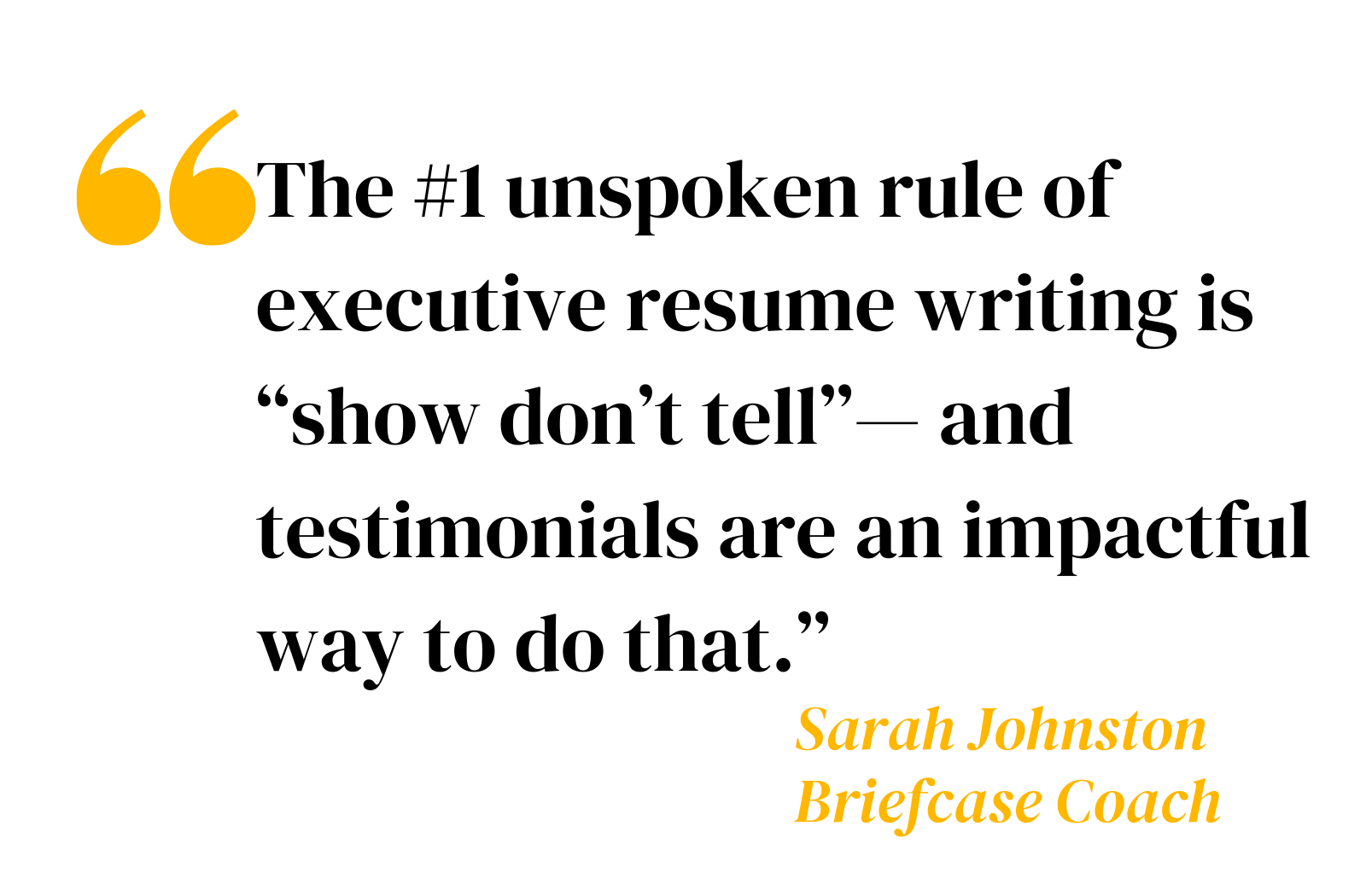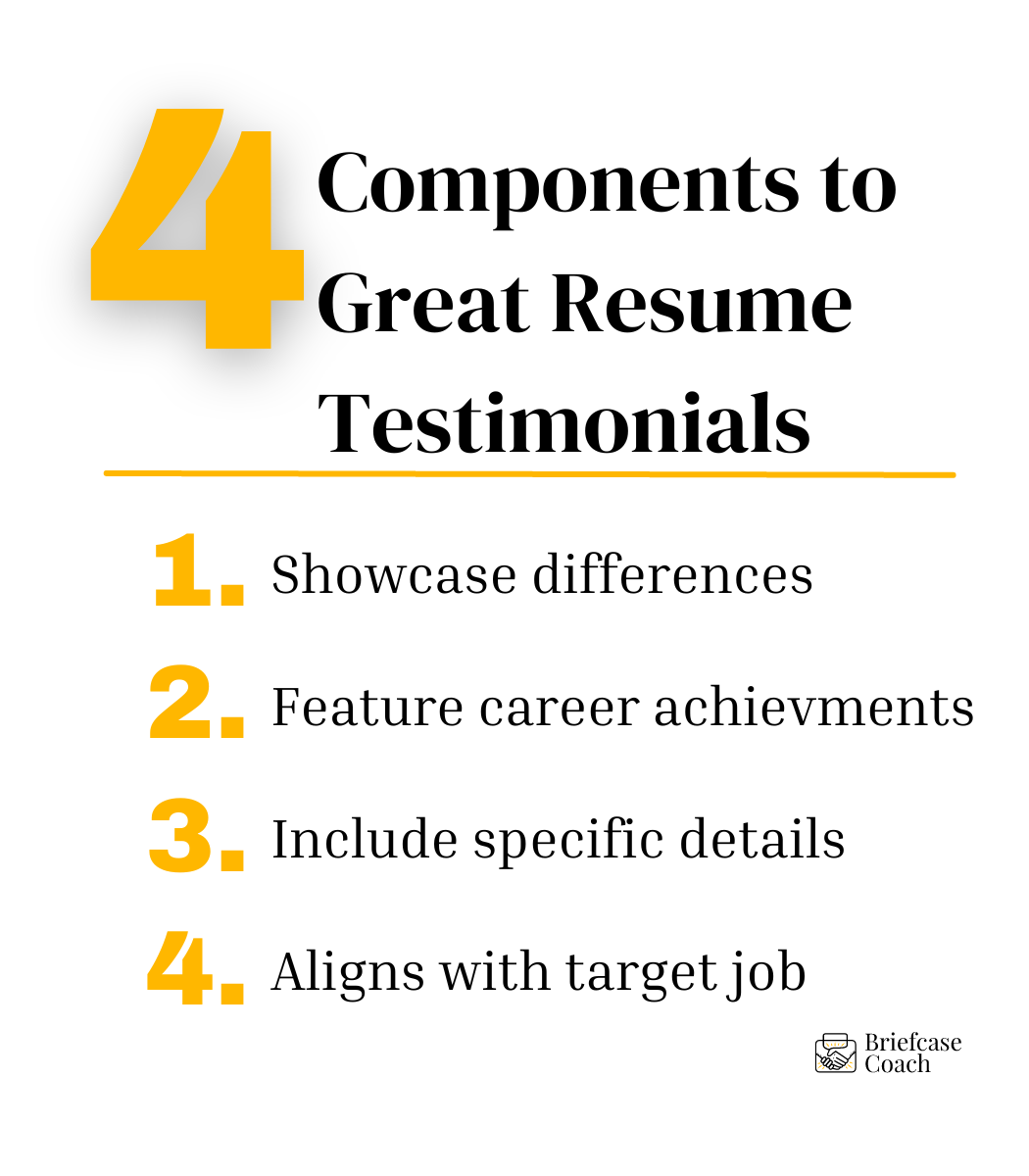How To Use Testimonials in Your Resume
You already know how important it is to include detailed job experiences, keywords, and compelling data about your achievements (if possible) on your resume. But beyond including these necessities, how do you get yours to stand out from the crowd in a hyper-competitive market? One way to is to consider adding testimonials, a practice that has been gaining traction in recent years.
Enhancing Resumes Using Testimonials
“I love seeing a few, thoughtful testimonials on a resume,” says retail recruiter and founder of J Recruiting Services, Jenn Hahn. “Quotes from others offer insights into how colleagues, leaders or direct reports see that candidate in a work setting. It is … more personal and genuine than what most people can legally share in a reference check. It also isn’t very common so when it’s done well, it helps make the candidate stand out.”
Executive resume writer Erin Kennedy concurs. In a LinkedIn article she states, “Adding testimonials to your resume is an art form. They build credibility…and reiterate what your expertise is in. They also offer insight into how your boss or peers view you. What do they think you are great at? Why do they think you are an integral part of the team? If written well, a testimonial can reemphasize your strengths, skillset, expertise, or even brief accomplishments.”
Briefcase Coach founder, Sarah Johnston’s opinion on the topic has evolved. “I used to think of testimonials on resumes as “fluff,” however I now think of a resume as a marketing and branding tool vs. a chronological list of work experience. This is a slight but big distinction. Testimonials on a branding tool can help reinforce themes (like execution, collaboration, etc). The #1 unspoken rule of executive resume writing is “show don’t tell”— and testimonials are an impactful way to do that.”
Testimonials Provide Valuable Social Proof on a Resume
In addition to helping to reinforce specific themes a job seeker wants to convey, testimonials on a resume communicate valuable social proof.
Executive resume writer and owner of Career Impressions, Adrienne Tom adds “Testimonials are an excellent way to add social proof to a resume, as they give the reader insights into how other people describe your work style, performance, and abilities. These descriptive snippets can carry a lot of weight as they are not your opinion — but others.”

The testimonial can be even more valuable if the person who is giving the testimonial is highly regarded in the industry. Executive search partner Jonathan McIntosh, CPC says, “As a head-hunter, I don’t take much stock in previously requested references or testimonials… for the simple reason that everyone (most everyone) can find one or two folks that will speak well of them. However, this changes if the testimonial is a known entity or respected person either in the industry I’m recruiting for or to the organization that I’m recruiting for.”
Ingredients of Great Resume Testimonials

Be careful, though, to use only those testimonials (or parts of testimonials), that will have the greatest impact. “If the quote you are using doesn’t support the position you’re applying for, remove it,” according to Indeed.com.
Remember that the best testimonials do the following:
- Highlight what makes you different
- Include career accomplishments and keywords
- Feature details that are specific (not vague)
- Resonate with the actual job you are pursuing
In particular, according to Laura Smith-Proulx, an executive resume expert quoted in a recent Forbes.com article, you should make sure that your testimonial includes data-driven statements. If you increased sales by a certain percentage, include those numbers. If you led a large team, state how many people were on it.
Adrienne Tom also stresses that testimonials should not “distract or detract from core messaging.” To do this, include short, supportive, and specific details,” she says. “A few carefully chosen lines are better than lengthy blocks of text to ensure critical points pop off the page. You should also only spotlight strengths and skills that align with the target job and support brand messaging. A short line that says, “John was a great leader and a hard worker,” doesn’t tell the reader very much and is a waste of precious resume real estate.”
3 Ways to Include Testimonials On Your Resume
There are numerous tactics to include testimonials on your resume. Here are three good ways, according to TopResume.com.
1) Add testimonials underneath each job position
Great Resumes Fast‘s Jessica Hernandez, an expert in brand-focused resumes for executives, recommends “including a testimonial in the top third of your resume or with the section that corresponds with the employer or client who gave you the feedback. “Think about what you want to communicate most to the reader – your skill set? Leadership abilities? Results? Then select an appropriate quote of 1-2 lines that speaks to the point you want to convey.”

2) Create an “Endorsements” section of your resume
Consider creating a separate section to your resume entitled “Testimonials” or “Endorsements.” Choose your testimonials judiciously and be sure they show a range of your skills, personality, and achievements.
3) Use testimonials to help fill unused white space
If you have a large gap at the bottom of the second page of your resume, consider adding testimonials here. Do not, however, extend your resume beyond two pages just to include testimonials.
It goes without saying that you need to be sure that you are choosing great testimonials rather than using quotes to fill the space.
Beyond Testimonials: Using Performance Reviews and LinkedIn Recommendations
What do you do, though, if you don’t have any great testimonials? Don’t despair! There are other places to mine to use on your resume.
“I always recommend clients mine their performance reviews and LinkedIn recommendations for gems to include on the resume, or even in the cover letter,” says Certified Resume Writer Jennifer Fishberg. “What others say about us often carries more weight than what we say about ourselves, particularly when it comes to soft skills.”
Cathy Lanzalaco, a career coach, concurs. In a response to Briefcase Coach’s post about using testimonials in a resume, she wrote “LinkedIn Recommendations live on in perpetuity–they promote your brand to everyone visiting your profile and using them on resumes and other career marketing documents is a wonderful way to expand their impact.
Mark Ikemoto, a job and career seekers coach, offers one important caveat when using LinkedIn recommendations. “If someone writes a recommendation for you in your LinkedIn profile Recommendations section, get a snapshot or screen capture of it. Do NOT rely on LinkedIn to keep the recommendation.”
Ikemoto speaks from personal experience. He had a great recommendation on LinkedIn from a former boss. Tragically, this individual died in a car accident. When LinkedIn closed the man’s membership, his recommendation for Ikemoto disappeared from his profile. Luckily, Ikemoto had kept a screenshot of it on his computer. But the lesson was learned. Keep all copies of recommendations and endorsements at home or saved on a home computer.

How to Get Testimonials
Many Briefcase Coach clients utilize content extracted from their performance appraisals, which often include quotes highlighting both hard and soft skills. Public emails announcing a leadership change or promotion are also often rich with quotable quotes. The 360-degree feedback component of a performance evaluation is also a potential content source.
If you lack a testimonial or don’t possess the appropriate one showcasing the essential soft skills for a prospective job opportunity, we suggest reaching out to a former boss, mentor, or colleague who has a deep understanding of your abilities and requesting them to write one for you. We advise inquiring if your contact is willing to write a testimonial publicly on LinkedIn so that it’s viewable by anyone checking out your profile. The public testimonial could then be repurposed for the resume by extracting a 1-3 sentence snippet.
Do’s and Don’ts For Using Testimonials in a Resume
DO: Be selective. One to three impactful, detailed testimonials are much better than 5 general or vague ones (but if you are putting testimonials in one section, use only two or three)
DO: Always ask for permission to use a testimonial
DON’T: Use quotes that aren’t relevant to your job search
DON’T: Forget to use testimonials that include keywords
DO: Include the testimonial writer’s job title if at all possible. “The title (like COO or Marketing Analyst (direct report) ) helps a lot with context and makes [the testimonial] more believable to me,” says Jenn Hahn.
DO: Keep all copies of recommendations and endorsements at home or saved on a home computer.
DON’T: Forget to ask for testimonials or written recommendations throughout your career. You’d be amazed how many people overlook this crucial step!


